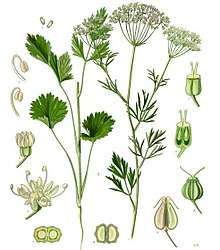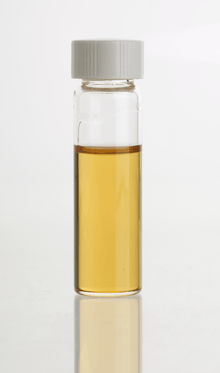Anise
Anise (/ˈænɪs/;[3] Pimpinella anisum), also called aniseed or rarely anix,[4] is a flowering plant in the family Apiaceae native to the eastern Mediterranean region and Southwest Asia.[5]
| Anise | |
|---|---|
 | |
| 1897 illustration[1] | |
| Scientific classification | |
| Kingdom: | Plantae |
| Clade: | Tracheophytes |
| Clade: | Angiosperms |
| Clade: | Eudicots |
| Clade: | Asterids |
| Order: | Apiales |
| Family: | Apiaceae |
| Genus: | Pimpinella |
| Species: | P. anisum |
| Binomial name | |
| Pimpinella anisum | |
| Synonyms[2] | |
|
Synonymy
| |
The flavor and aroma of its seeds have similarities with some other spices, such as star anise,[4] fennel, and liquorice. It is widely cultivated and used to flavor food and alcoholic drinks, especially around the Mediterranean.
Etymology
The name "anise" is derived via Old French from the Latin word, anisum, or Greek, anison, referring to dill.[6]
Description


Anise is an herbaceous annual plant growing to 3 ft (0.9 m) or more tall. The leaves at the base of the plant are simple, 3⁄8–2 in (1–5 cm) long and shallowly lobed, while leaves higher on the stems are feathery pinnate, divided into numerous small leaflets. The flowers are either white or yellow, approximately 1⁄8 inch (3 mm) in diameter, produced in dense umbels. The fruit is an oblong dry schizocarp, 1⁄8–1⁄4 in (3–6 mm) long, usually called "aniseed".[7]
Anise is a food plant for the larvae of some Lepidoptera species (butterflies and moths), including the lime-speck pug and wormwood pug.
Cultivation
.jpg)
Anise was first cultivated in Egypt and the Middle East, and was brought to Europe for its medicinal value.[8] It has been cultivated in Egypt for approximately 4,000 years.
Anise plants grow best in light, fertile, well-drained soil. The seeds should be planted as soon as the ground warms up in spring. Because the plants have a taproot, they do not transplant well after being established, so they should either be started in their final location or be transplanted while the seedlings are still small.[9]
Production
Western cuisines have long used anise to flavor dishes, drinks, and candies. The word is used for both the species of herb and its licorice-like flavor. The most powerful flavor component of the essential oil of anise, anethole, is found in both anise and an unrelated spice indigenous to northern China[10] called star anise (Illicium verum) widely used in South Asian, Southeast Asian, and East Asian dishes. Star anise is considerably less expensive to produce, and has gradually displaced P. anisum in Western markets. While formerly produced in larger quantities, by 1999 world production of the essential oil of anise was only 8 tons, compared to 400 tons of star anise.[11]
Composition

As with all spices, the composition of anise varies considerably with origin and cultivation method. These are typical values for the main constituents.[12]
- Moisture: 9–13%
- Protein: 18%
- Fatty oil: 8–23%
- Essential oil: 2–7%
- Starch: 5%
- N-free extract: 22–28%
- Crude fibre: 12–25%
In particular, the anise seeds products should also contain more than 0.2 milliliter volatile oil per 100 grams of spice.[13]
Essential oil
Anise essential oil can be obtained from the fruits by either steam distillation or extraction using supercritical carbon dioxide.[14] The yield of essential oil is influenced by the growing conditions[15] and extraction process, with supercritical extraction being more efficient.[14] Regardless of the method of isolation the main component of the oil is anethole (80–90%), with minor components including 4-anisaldehyde, estragole and pseudoisoeugenyl-2-methylbutyrates, amongst others.[16] Anethole is responsible for anise's characteristic odor and flavor.[17]
Uses
Culinary

Anise is sweet and very aromatic, distinguished by its characteristic flavour.[7] The seeds, whole or ground, are used for preparation of teas and tisanes (alone or in combination with other aromatic herbs), as well as in a wide variety of regional and ethnic confectioneries, including black jelly beans, British aniseed balls and "troach" drops,[18] Australian humbugs, New Zealand aniseed wheels, Italian pizzelle, German Pfeffernüsse and Springerle, Austrian Anisbögen, Dutch muisjes, New Mexican bizcochitos, and Peruvian picarones. It is a key ingredient in Mexican atole de anís and champurrado, which is similar to hot chocolate, and it is taken as a digestive after meals in India and Pakistan.
The ancient Romans often served spiced cakes with aniseed called mustaceoe[19] at the end of feasts as a digestive. This tradition of serving cake at the end of festivities is the basis for the tradition of serving cake at weddings.[20]
Liquor

Anise is used to flavor Greek ouzo;[21] Italian sambuca;[21] Bulgarian and Macedonian mastika;[21] French absinthe, anisette,[22] and pastis;[23] Spanish Anís del Mono,[24] Anísado[21] and Herbs de Majorca;[25] Turkish and Armenian rakı;[21] Lebanese, Egyptian, Syrian, Jordanian, and Israeli arak;[21] and Algerian Anisette Cristal.[21] Outside the Mediterranean region, it is found in Colombian aguardiente[22] and Mexican Xtabentún.[26] These liquors are clear, but on addition of water become cloudy, a phenomenon known as the ouzo effect.[27][28]
Anise is used together with other herbs and spices in some root beers, such as Virgil's in the United States.[29][30]
Traditional medicine
The main use of anise in traditional European herbal medicine was for its carminative effect (reducing flatulence),[4] as noted by John Gerard in his Great Herball, an early encyclopedia of herbal medicine:
The seed wasteth and consumeth winde, and is good against belchings and upbraidings of the stomacke, alaieth gripings of the belly, provoketh urine gently, maketh abundance of milke, and stirreth up bodily lust: it staieth the laske (diarrhea), and also the white flux (leukorrhea) in women.[31]
According to Pliny the Elder, anise was used as a cure for sleeplessness, chewed with alexanders and a little honey in the morning to freshen the breath, and, when mixed with wine, as a remedy for asp bites (N.H. 20.72).[32] In 19th-century medicine, anise was prepared as aqua anisi ("Water of Anise") in doses of an ounce or more and as spiritus anisi ("Spirit of Anise") in doses of 5–20 minims.[8] In Turkish folk medicine, its seeds have been used as an appetite stimulant, tranquilizer, or diuretic.[33]
Other uses
Builders of steam locomotives in Britain incorporated capsules of aniseed oil into white metal plain bearings, so the distinctive smell would give warning in case of overheating.[34] Anise can be made into a liquid scent and is used for both drag hunting and fishing. It is put on fishing lures to attract fish.[35][36]
References
- from Franz Eugen Köhlae, Köhlae's Medizinal-Pflanzen, 1897
- The Plant List, Pimpinella anisum L.
- Oxford English Dictionary, 1st ed. "anise, n." Oxford University Press (Oxford), 1884.
- Baynes 1878.
- Altervista Flora Italiana, Anice vera, Pimpinella anisum L.
- "Anise". Oxford Dictionaries, Oxford University Press. 2018. Retrieved 3 March 2018.
- Anise (Pimpinella anisum L.) from Gernot Katzer’s Spice Pages
- Chisholm 1911.
- How to Grow Anise Archived August 21, 2008, at the Wayback Machine from growingherbs.org.uk
- Peter, K. V. (2004). Handbook of Herbs and Spices. Woodhead Publishing. p. 290. ISBN 978-1-85573-721-1.
- Philip R. Ashurst (1999). Food Flavorings. Springer. p. 33. ISBN 978-0-8342-1621-1.
- J.S. Pruthi: Spices and Condiments, New Delhi: National Book Trust (1976), p. 19.
- Branch, Legislative Services. "Consolidated federal laws of canada, Food and Drug Regulations". laws.justice.gc.ca. Retrieved 2018-07-19.
- Pereira, Camila G.; Meireles, M. Angela A. (September 2007). "Economic analysis of rosemary, fennel and anise essential oils obtained by supercritical fluid extraction". Flavour and Fragrance Journal. 22 (5): 407–413. doi:10.1002/ffj.1813.
- Zehtab-salmasi, S.; Javanshir, A.; Omidbaigi, R.; Alyari, H.; Ghassemi-golezani, K. (May 2001). "Effects of water supply and sowing date on performance and essential oil production of anise (Pimpinella anisum L.)". Acta Agronomica Hungarica. 49 (1): 75–81. doi:10.1556/AAgr.49.2001.1.9.
- Rodrigues, Vera M.; Rosa, Paulo T. V.; Marques, Marcia O. M.; Petenate, Ademir J.; Meireles, M. Angela A. (March 2003). "Supercritical Extraction of Essential Oil from Aniseed using sCO2: Solubility, Kinetics, and Composition Data". Journal of Agricultural and Food Chemistry. 51 (6): 1518–1523. doi:10.1021/jf0257493. PMID 12617576.
- Jodral, Manuel Miro. Illicium, Pimpinella and Foeniculum. CRC Press, 2004. pp. 205
- "FWB - Aniseed/Troach Drops (Wrapped)". www.thewelshsweetshop.com. Retrieved 14 August 2018.
- "Anise History". Our Herb Garden. March 2013. Retrieved 3 March 2013.
- "Wedding Cake: A Slice of History | Carol Wilson". Gastronomica. 2005-05-05. Retrieved 2017-11-13.
- Dealberto, Clara; Desrayaud, Lea (25 July 2017). "Le pastis, elixir provencal". Le Monde. Le Monde. p. 28.
- "16 Anise-Flavored Liquors | SenseList". senselist.com. Retrieved 13 November 2017.
- Blocker, Jack S. Jr.; Fahey, David M.; Tyrrell, Ian R. (2003). Alcohol and Temperance in Modern History: An International Encyclopedia. ABC-CLIO. pp. 478–. ISBN 978-1-57607-833-4. Retrieved 28 March 2013.
- Zurdo, David; Gutiérrez, Ángel (2004). El libro de los licores de España. Ediciones Robinbook. p. 50. ISBN 9788496054127. Retrieved 5 February 2013.
- "Majorcan herb liqueur in Spain". Spain.info. 2007-04-23. Retrieved 22 January 2018.
- "Xtabentún Cocktail Guide, with Origins and Recipes". Wine Enthusiast Magazine. 29 February 2012. Retrieved 13 November 2017.
- Sitnikova, Natalia L.; Sprik, Rudolf; Wegdam, Gerard; Eiser, Erika (2005). "Spontaneously Formed trans-Anethol/Water/Alcohol Emulsions: Mechanism of Formation and Stability". Langmuir. 21 (16): 7083–7089. doi:10.1021/la046816l. PMID 16042427.
- Ganachaud, François; Katz, Joseph L. (2005). "Nanoparticles and Nanocapsules Created Using the Ouzo Effect: Spontaneous Emulsification as an Alternative to Ultrasonic and High-Shear Devices". ChemPhysChem. 6 (2): 209–216. doi:10.1002/cphc.200400527. PMID 15751338.
- "Virgil's Bavarian Nutmeg". Reeds. Archived from the original on April 21, 2014. Retrieved May 12, 2014.
- "Virgil's Rootbeer – Spike's Root Beer Reviews and Ratings". Root Beer Reviews. Retrieved May 12, 2014.
- John Gerard, The Herball, or Generall Historie of Plantes, 1597, p. 880, side 903
- Pliny (1856). "Book XX. Anise—sixty-one remedies". The Natural History of Pliny. 4. translators John Bostock, Henry Riley. London: Henry Bohn. pp. 271–274. OCLC 504358830.
- Baytop, T. (1999) Therapy with medicinal plants in Turkey, Past and Present. Kitapevi, Istanbul, Turkey, 2nd edition, pp. 142.
- The Railway Magazine. 99: 287. 1953.CS1 maint: untitled periodical (link)
- Collins, Tony (2005). Encyclopedia of traditional British rural sports. Abingdon, England: Routledge. p. 140. ISBN 978-0-415-35224-6.
- Gabriel, Otto; von Brandt, Andres (2005). Fish catching methods of the world (4 ed.). Oxford, England: Blackwell. pp. 153–4. ISBN 978-0-85238-280-6.
Further reading

- Chisholm, Hugh, ed. (1911), , Encyclopædia Britannica, 2 (11th ed.), Cambridge University Press, p. 55CS1 maint: ref=harv (link)